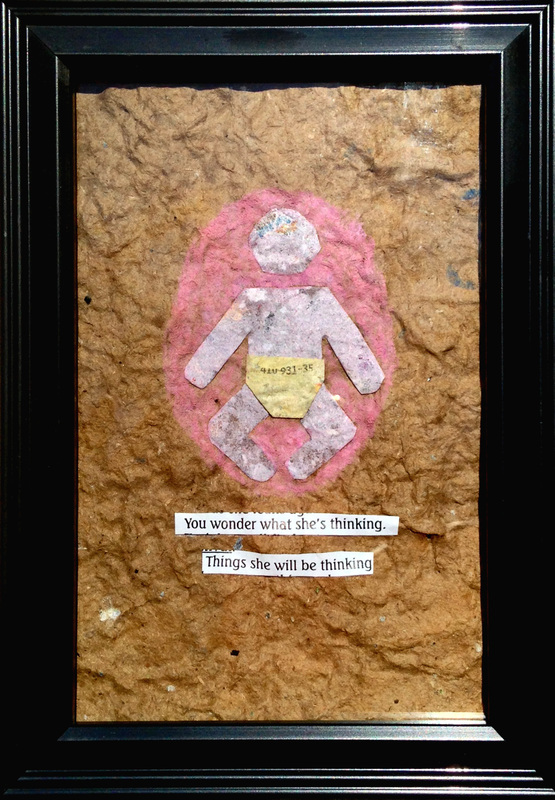I created a work especially for this exhibition. I called it "What She's Thinking". It was a very small collage made from handmade paper and found text in catalogs. While it wasn't an "in-your-face" feminist piece, I meant for it to be a reminder that babies and humans (and therefore females) are thinking creatures. Babies, girls, and women absorb the information, behaviors and cultures around them, so shouldn't we take a little responsibility as individuals and as a society to make sure the females of the world are happy and healthy? Shouldn't we encourage and recognize positive and powerful thinking in women? I was hoping this art piece, though simple, would provoke some important questions.
My view is that applying for competitions, shows and opportunities is just like applying for a job every time. You have to first read carefully about the opportunity to make sure you would be a good fit, then you have to make sure your application materials show your work is relevant to the opportunity. A wise extra step would be to do a little research on the judge/jury of the opportunity. You should normally try to do this, especially with calls for entries that require a fee. You don't want to throw away your money on an opportunity you're not likely to get because the decision-makers have completely different perspectives from you. Applying for these opportunities takes time and commitment, just like when you apply for a job. And sometimes "they" like you, and sometimes they don't. It comes down to being a good fit.
The bottom line is, when you are rejected for an opportunity, it simply means you were not what they were looking for. Some people think that's a tough pill to swallow, but really it's not. Everyone should know by now that art is highly subjective. Just because you believe your work is "feminist" enough, doesn't mean others will. Or, the issue may simply be that your work was too big, small or otherwise problematic when grouped with the other pieces in the space. Or, maybe it was the space altogether--sometimes certain lighting, walls, and other factors would not be complimentary to your piece. Also, there are times when your art might a good choice under other circumstances, but maybe the curators have too many collages this time and want to include more sculptures for the exhibition.
Then there may be times when you should take part of the blame for your own rejection. If you know a particular exhibition aims to sell as many high-priced art pieces as possible, and you submit a work with a suggested price of $50, you probably recognize there is a high risk of rejection. Also, if your work is getting consistently rejected though you believe you are applying for the right opportunities, there may be a problem with how your work is photographed, the accompanying information you're providing, your professionalism, or maybe the work itself is not what they're looking for. When you find your work doesn't appeal to a very wide audience, that can become very discouraging, very fast. If you realize most of the world doesn't "get" or like your art, it is up to you whether you want to modify your pieces and create new work that is somehow more "mainstream", or continue working in the same manner, but just realize you'll need to toughen up and work harder to find the opportunities right for you.
Though there are times when I am rejected from exhibiting in a show that I wanted, I do think it's harder when I don't win competitions because there are chosen "winners" and that means I'm the "loser". Even in these cases, however, the fact remains that I was not what the judges/jury/gallery/museum/art buyer were looking for. Everyone is looking for something different, and sometimes I am not it. But, just like applying for jobs or anything worthwhile in life, you have to keep trying. Over time you change, the judges change, the world changes, and sometimes you just have to wait for the stars to align.
But you have to be ready, willing, and watching for the next opportunity.

 RSS Feed
RSS Feed
